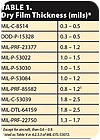FINISHING DEFENSE: Film Thickness: Are You Giving Uncle Sam What "We" Paid For?
Paying attention to the film thickness requirements not only will make sure you are in compliance with the specifications, but also will keep your customers happy because you are giving them and Uncle Sam what “we” paid for.
Do you know what your film thickness requirements are? Are you in compliance?
Before you read on, I want you to write down on a piece of paper what the minimum total dry film thickness (DFT) requirement is for the CARC system you are using in your facility. Go on, write it down. Fold it in half and do not look at it again until you finish the rest of this article.

The Army and the other related arms of the Department of Defense have gone to great lengths to provide coating specifications. Years and years of testing have been performed to ensure that our troops not only have the best tactical equipment in the world, but also that the coating systems on the equipment are going to hold up under the harsh environments to which they are subjected.
Each specification clearly states a minimum DFT requirement. For example, the exterior CARC topcoats MIL-DTL-53039 and MIL-DTL-64159 have a minimum DFT requirement of 1.8 to 2.5 mils. Not 1.0 or 1.5, but 1.8 mils. The Army knows that at 1.8 mils dry, the coating has developed its chemical agent resistance and can withstand a chemical decontamination or chemical wash without compromising its integrity. If you are applying MIL-P-53022 or MIL-P-53030, then you should know that the minimum DFT is 1.0 to 1.5 because with a properly prepared substrate per TT-C-490, the part will meet the corrosion resistance requirement. Table 1 shows a sample chart from 4.2.3.3 of MIL-DTL-53072.
For example, a CARC system that consists of MIL-C-8514 as the pre-treatment, MIL-P-53022 as the primer, and MIL-DTL-53039 (formerly MIL-C-53039) as the topcoat will have a minimum DFT of 3.1 mils. (Remember that on a blasted substrate the profile has to be factored in, and the DFT is always calculated over the peak.)
Many parts are challenging to paint due to their complex crevice geometry. It is impractical to expect to hold film thicknesses to a minimum, but every possible measure should be taken to control excessive film build and maintain a uniform appearance. Excessive film build usually opens the door for problems such as extending dry-to-handle times, intercoat adhesion issues and, of course, “blisters.” Not to mention the amount of money you are throwing away just by applying more paint than is necessary.
Paying attention to the film thickness requirements not only will make sure you are in compliance with the specifications, but also will keep your customers happy because you are giving them and Uncle Sam what “we” paid for.
Do you know what your film thickness requirements are? Are you in compliance?
Before you read on, I want you to write down on a piece of paper what the minimum total dry film thickness (DFT) requirement is for the CARC system you are using in your facility. Go on, write it down. Fold it in half and do not look at it again until you finish the rest of this article.

The Best Protection
If any of you have had the pleasure of experiencing a TACOM audit, then you know that film thickness is a major focal point and is not taken lightly.The Army and the other related arms of the Department of Defense have gone to great lengths to provide coating specifications. Years and years of testing have been performed to ensure that our troops not only have the best tactical equipment in the world, but also that the coating systems on the equipment are going to hold up under the harsh environments to which they are subjected.
Each specification clearly states a minimum DFT requirement. For example, the exterior CARC topcoats MIL-DTL-53039 and MIL-DTL-64159 have a minimum DFT requirement of 1.8 to 2.5 mils. Not 1.0 or 1.5, but 1.8 mils. The Army knows that at 1.8 mils dry, the coating has developed its chemical agent resistance and can withstand a chemical decontamination or chemical wash without compromising its integrity. If you are applying MIL-P-53022 or MIL-P-53030, then you should know that the minimum DFT is 1.0 to 1.5 because with a properly prepared substrate per TT-C-490, the part will meet the corrosion resistance requirement. Table 1 shows a sample chart from 4.2.3.3 of MIL-DTL-53072.
For example, a CARC system that consists of MIL-C-8514 as the pre-treatment, MIL-P-53022 as the primer, and MIL-DTL-53039 (formerly MIL-C-53039) as the topcoat will have a minimum DFT of 3.1 mils. (Remember that on a blasted substrate the profile has to be factored in, and the DFT is always calculated over the peak.)
A Matter of Control
Now let’s unfold that piece of paper and see how you did. Did you measure up? Of course you did. Congratulations!Many parts are challenging to paint due to their complex crevice geometry. It is impractical to expect to hold film thicknesses to a minimum, but every possible measure should be taken to control excessive film build and maintain a uniform appearance. Excessive film build usually opens the door for problems such as extending dry-to-handle times, intercoat adhesion issues and, of course, “blisters.” Not to mention the amount of money you are throwing away just by applying more paint than is necessary.
Paying attention to the film thickness requirements not only will make sure you are in compliance with the specifications, but also will keep your customers happy because you are giving them and Uncle Sam what “we” paid for.
Looking for a reprint of this article?
From high-res PDFs to custom plaques, order your copy today!




